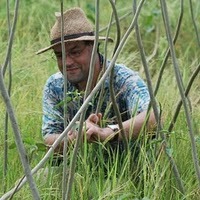
Chie Akashi
Related Authors
John M. Marston
Boston University
Dorian Q Fuller
University College London
Marco Valenti
University of Siena / Università di Siena
Guillermo García-Contreras Ruiz
University of Granada
girolamo fiorentino
University of Salento
Mirosław Furmanek
University of Wroclaw
Ferran Antolín
German Archaeological Institute
Oliver Dietrich
Landesamt für Denkmalpflege und Archäologie Sachsen-Anhalt
Adnan Baysal
Ankara University
Jaromír Beneš
University of South Bohemia









Uploads
Papers by Chie Akashi
Free access to this article until January 13, 2015
http://authors.elsevier.com/a/1Q5FU15SlTQf7A
This paper presents direct evidence for cereal storage by Neolithic farmers in west Asia. Storage features analyzed this study are circular clay bins that frequently occur at Neolithic settlements (8th millennium cal. BP) in the southern Caucasus. We examined contexts and uses of clay bin features at the Neolithic settlement of Göytepe (Azerbaijan). We analyzed biogenic microfossil evidence (primarily from phytoliths and dung spherulites) and the sediments of the clay bins through micromorphology, in combination with their associated charred macrobotanical remains. While phytoliths and charred botanical remains indicate direct remnants of stored plants, mainly chaffs, micromorphology and the analyses of faecal spherulites allow us to examine depositional and diagenetic processes of the archaeological sediments inside and outside these features. As a result, one of the clay bins was found to retain deposits at its base exhibiting high concentrations of grass phytoliths with relatively high proportions of inflorescences and low percentages of anatomically connected phytoliths in comparison with its upper fill deposits and areas outside of the bin. These finds, combined with the association of the two complete grinding stones inside the bottom of the bin, suggest that the remains of cereal processing activities, specifically dehusking, may have been placed in the bin. This interpretation is corroborated by the recovery of charred rachises and chaffs of wheat and barley as well as micromorphological observations that the bottommost fill of the bin consists almost entirely of grass phytoliths with few very small charcoal fragments and fine amorphous organic matter.
"inside and outside these features. As a result, one of the clay bins was found to retain deposits at its base exhibiting high concentrations of grass phytoliths with relatively high proportions of inflorescences and low percentages of anatomically connected phytoliths in comparison with its upper fill deposits and areas outside of the bin. These finds, combined with the association of the two complete grinding stones inside the bottom of the bin, suggest that the remains of cereal processing activities, specifically dehusking, may have been placed in the bin. This interpretation is corroborated by the recovery of charred rachises and chaffs of wheat and barley as well as micromorphological observations that the bottommost fill of the bin consists almost entirely of grass phytoliths with few very small charcoal fragments and fine amorphous organic matter."
Free access to this article until January 13, 2015
http://authors.elsevier.com/a/1Q5FU15SlTQf7A
This paper presents direct evidence for cereal storage by Neolithic farmers in west Asia. Storage features analyzed this study are circular clay bins that frequently occur at Neolithic settlements (8th millennium cal. BP) in the southern Caucasus. We examined contexts and uses of clay bin features at the Neolithic settlement of Göytepe (Azerbaijan). We analyzed biogenic microfossil evidence (primarily from phytoliths and dung spherulites) and the sediments of the clay bins through micromorphology, in combination with their associated charred macrobotanical remains. While phytoliths and charred botanical remains indicate direct remnants of stored plants, mainly chaffs, micromorphology and the analyses of faecal spherulites allow us to examine depositional and diagenetic processes of the archaeological sediments inside and outside these features. As a result, one of the clay bins was found to retain deposits at its base exhibiting high concentrations of grass phytoliths with relatively high proportions of inflorescences and low percentages of anatomically connected phytoliths in comparison with its upper fill deposits and areas outside of the bin. These finds, combined with the association of the two complete grinding stones inside the bottom of the bin, suggest that the remains of cereal processing activities, specifically dehusking, may have been placed in the bin. This interpretation is corroborated by the recovery of charred rachises and chaffs of wheat and barley as well as micromorphological observations that the bottommost fill of the bin consists almost entirely of grass phytoliths with few very small charcoal fragments and fine amorphous organic matter.
"inside and outside these features. As a result, one of the clay bins was found to retain deposits at its base exhibiting high concentrations of grass phytoliths with relatively high proportions of inflorescences and low percentages of anatomically connected phytoliths in comparison with its upper fill deposits and areas outside of the bin. These finds, combined with the association of the two complete grinding stones inside the bottom of the bin, suggest that the remains of cereal processing activities, specifically dehusking, may have been placed in the bin. This interpretation is corroborated by the recovery of charred rachises and chaffs of wheat and barley as well as micromorphological observations that the bottommost fill of the bin consists almost entirely of grass phytoliths with few very small charcoal fragments and fine amorphous organic matter."